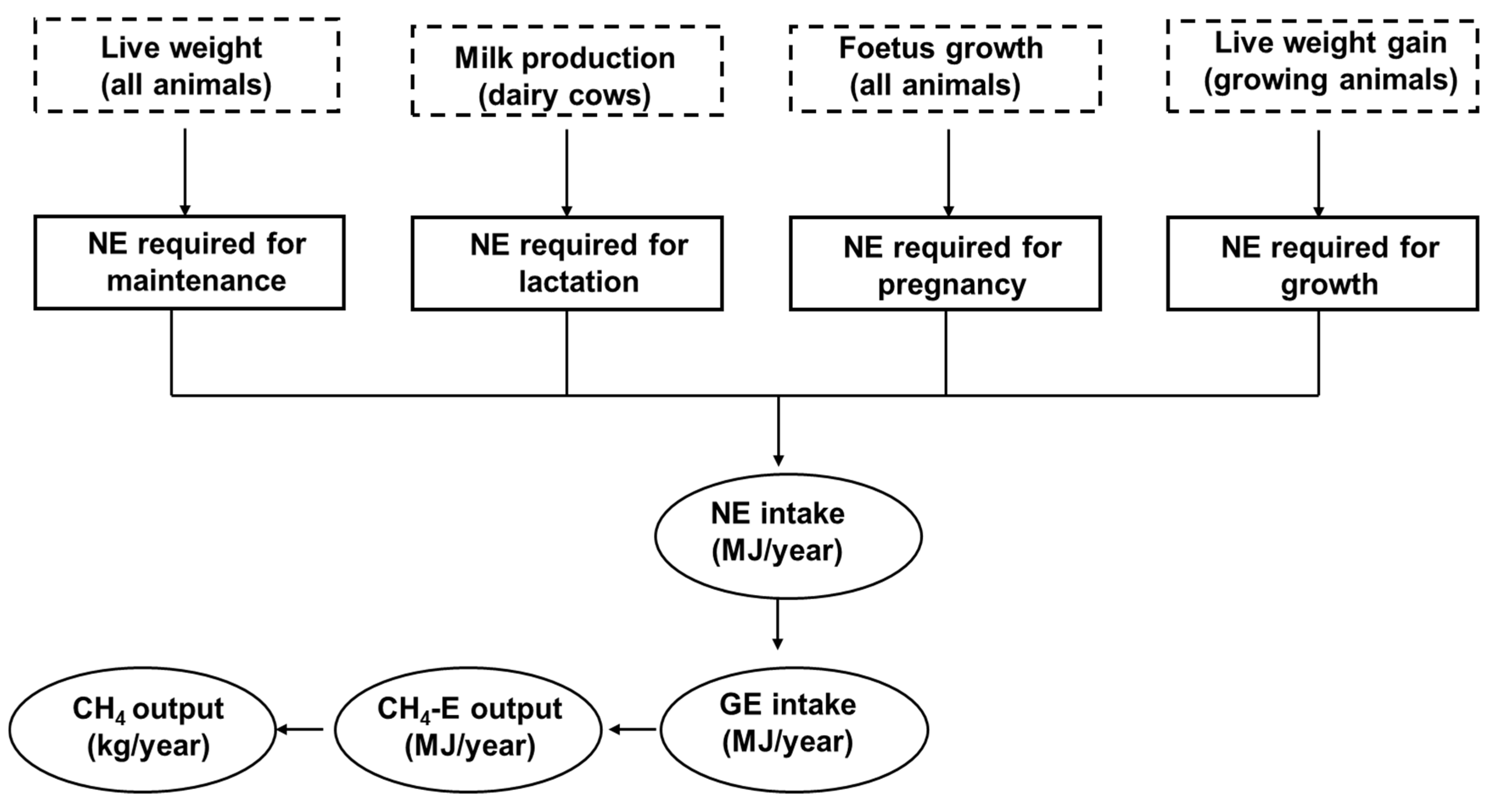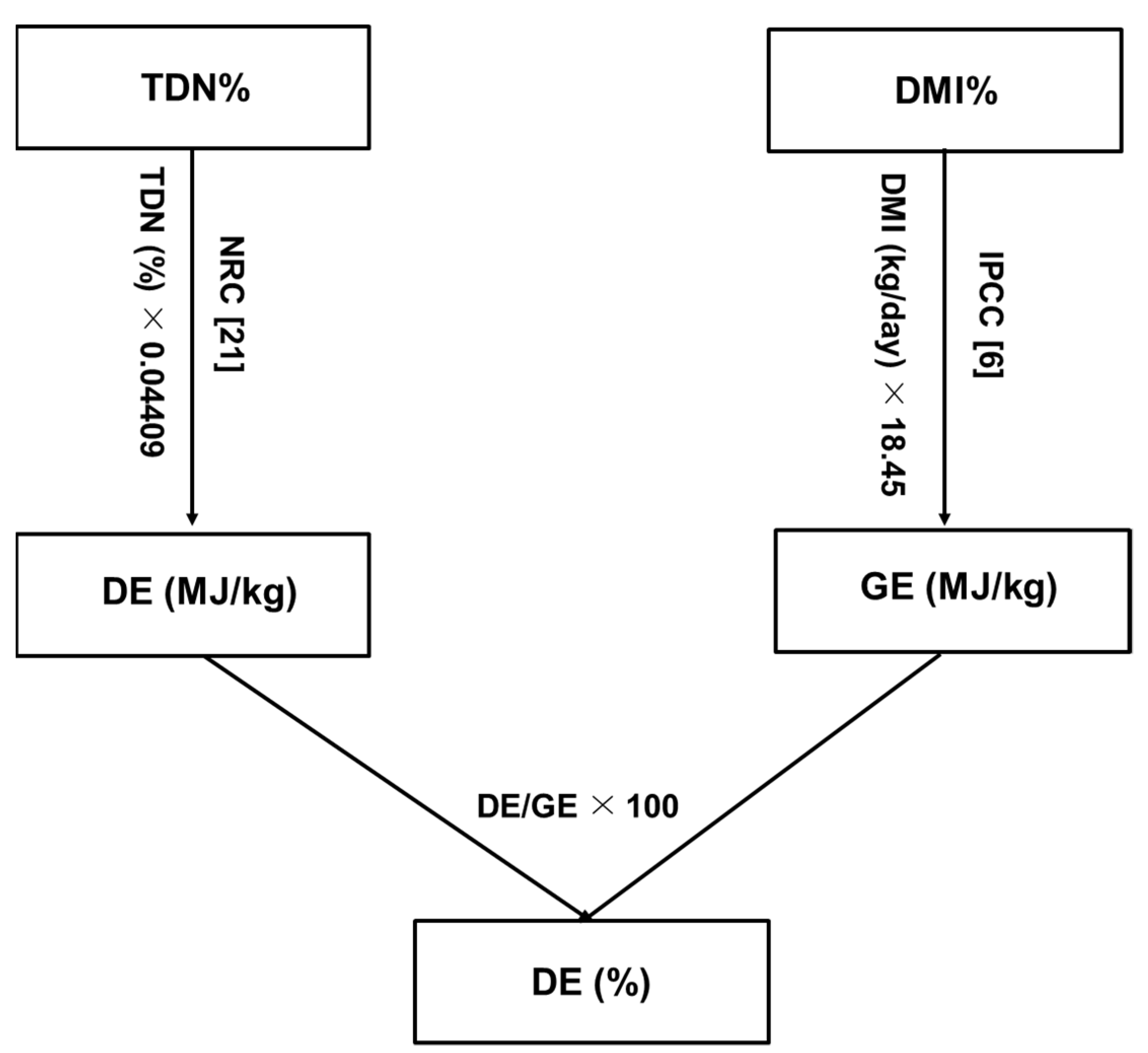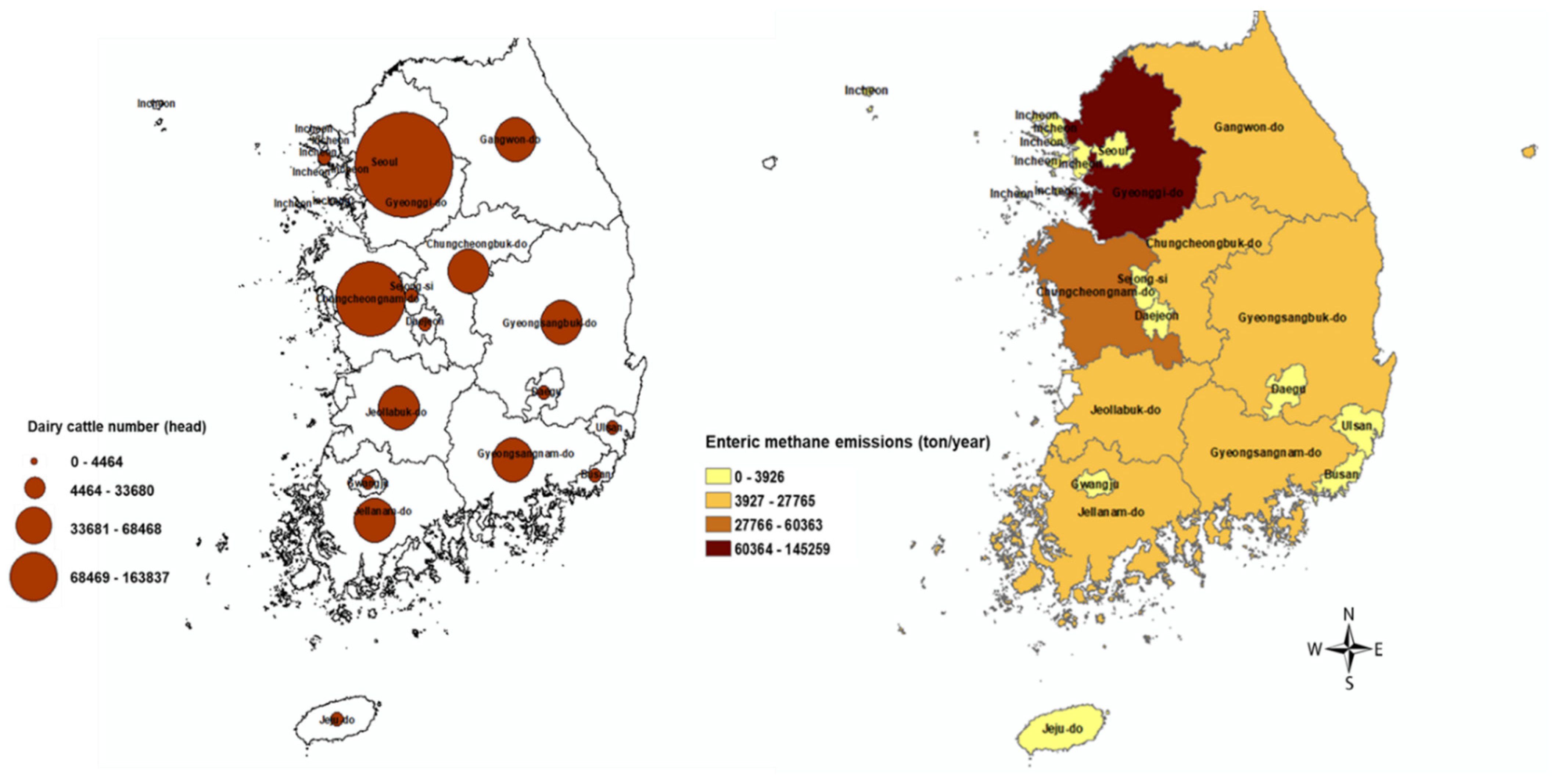Developing Country-Specific Methane Emission Factors and Carbon Fluxes from Enteric Fermentation in South Korean Dairy Cattle Production
Abstract
1. Introduction
2. Materials and Methods
2.1. Development of Tier 2 Enteric Methane Emission Factors for Dairy Cattle
2.2. Identification of Animal Subcategories, Breeds, and Body Weights
2.3. Milk Production and Fat Content
2.4. Feed Intake and Digestibility Assumption
2.5. Methane Conversion Rate Selection Process
3. Results and Discussion
3.1. National Enteric Methane Emission Factors of Dairy Cattle
3.2. Effect of Input Data on Enteric Methane Emission Factors
3.3. Mapping the Methane Flux from Enteric Fermentation
3.4. Implications of the Development of Enteric Methane Emission Factors
3.5. Emission Factor Uncertainty
4. Conclusions
Author Contributions
Funding
Institutional Review Board Statement
Informed Consent Statement
Data Availability Statement
Conflicts of Interest
References
- Gornall, J.; Betts, R.; Burke, E.; Clark, R.; Camp, J.; Willett, K.; Wiltshire, A. Implications of climate change for agricultural productivity in the early twenty-first century. Philos. Trans. R. Soc. B Biol. Sci. 2010, 365, 2973–2989. [Google Scholar] [CrossRef] [PubMed]
- Opio, C.; Gerber, P.; Steinfeld, H. Livestock and the environment: Addressing the consequences of livestock sector growth. Adv. Anim. Biosci. 2011, 2, 601. [Google Scholar] [CrossRef]
- Rojas-Downing, M.M.; Nejadhashemi, A.P.; Harrigan, T.; Woznicki, S.A. Climate change and livestock: Impacts, adaptation, and mitigation. Clim. Risk Manag. 2017, 16, 145–163. [Google Scholar] [CrossRef]
- Steinfeld, H.; Henderson, B.; Mottet, A.; Opio, C.; Dijkman, J.; Falcucci, A.; Tempio, G. Tackling Climate Change Through Livestock: A Global Assessment of Emissions and Mitigation Opportunities; Food and Agriculture Organization of the United Nations (FAO): Rome, Italy, 2013; ISBN 925107920X. [Google Scholar]
- Knapp, J.R.; Laur, G.L.; Vadas, P.A.; Weiss, W.P.; Tricarico, J.M. Invited review: Enteric methane in dairy cattle production: Quantifying the opportunities and impact of reducing emissions. J. Dairy Sci. 2014, 97, 3231–3261. [Google Scholar] [CrossRef]
- Intergovernmental Panel on Climate Change. 2019 Refinement to the 2006 IPCC Guidelines for National Greenhouse Gas Inventories; Intergovernmental Panel on Climate Change: Kanagawa, Japan, 2019. [Google Scholar]
- Intergovernmental Panel on Climate Change. Guidelines for national greenhouse gas inventories. general guidance and reporting. In IPCC National Greenhouse Gas Inventories Programme; Eggleston, H.S., Buendia, L., Miwa, K., Ngara, T., Tanabe, K., Eds.; Institute for Global Environmental Strategies: Hayama, Japan, 2006; Volume 1. [Google Scholar]
- Ha, S.; Tae, S.; Kim, R. A study on the limitations of South Korea′s National Roadmap for Greenhouse Gas Reduction by 2030 and suggestions for improvement. Sustainability 2019, 11, 3969. [Google Scholar] [CrossRef]
- Greenhouse gas inventory report (GIR) of Korea. Fourth National Communication of the Republic of Korea under the United Nations Framework Convention on Climate Change; Greenhouse Gas Inventory and Research Center: Seoul, Korea, 2019; Volume 1, pp. 23–24. [Google Scholar]
- Corazzin, M.; Schermer, M.; Park, S.-Y. Tools to retain added value in dairy farms: The South Korea case. J. Asian Rural. Stud. 2017, 1, 81–96. [Google Scholar] [CrossRef][Green Version]
- The International Committee for Animal Recording Biennial Statistics of Cow Milk, Sheep MILK and Beef Recording: Yearly Survey on the Situation of Milk Recording Systems in ICAR Member Countries for Cow, Sheep and Goats 2021. Available online: www.icar.org (accessed on 3 March 2021).
- Greenhouse gas inventory report (GIR) of Korea. Korea’s third national communication under the United Nations Framework Convention on climate change: Low carbon, green growth. Greenh. Gas Invent. Res. Cent. 2012, 1, 1–200. Available online: https://unfccc.int/resource/docs/natc/kornc3.pdf (accessed on 3 March 2021).
- Ominski, K.H.; Boadi, D.A.; Wittenberg, K.M.; Fulawka, D.L.; Basarab, J.A. Estimates of enteric methane emissions from cattle in Canada using the IPCC Tier-2 methodology. Can. J. Anim. Sci. 2007, 87, 459–467. [Google Scholar] [CrossRef]
- Wilkes, A.; Dijk, S. Tier 2 Inventory Approaches in the Livestock Sector: A Collection of Agricultural Greenhouse Gas Inventory Practices; CGIAR Research Program on Climate Change, Agriculture and Food Security (CCAFS): Wageningen, The Netherlands, 2018. [Google Scholar]
- Tongwane, M.I.; Moeletsi, M.E. Emission factors and carbon emissions of methane from enteric fermentation of cattle produced under different management systems in South Africa. J. Clean. Prod. 2020, 265, 121931. [Google Scholar] [CrossRef]
- Breiman, L. Random forests. Mach. Learn. 2001, 45, 5–32. [Google Scholar] [CrossRef]
- KOSTAT. Livestock Statistics Survey. 2019. Available online: http://kostat.go.kr/portal/eng/surveyOutline/1/10/index.static (accessed on 12 October 2020).
- Rural Development Administration. Korean Feeding Standards for Dairy Cattle, 3rd ed.; National Institute of Animal Science, Rural Development Administration (RDA): Suwon, Korea, 2017; Available online: http://lib.rda.go.kr/search/searchDetail.do?ctrl=000000217076&marcType=m&lang=kor&loca=rda00001&sysDiv=TOT&siteCode=home&sMenu=3010¶mStrlink=siteCode%3dhome%26amp%3bamp%3bsType%3dKWRD%26amp%3bamp%3bq%3d%25EA%25B0%2580%25EC%25B6%2595%25EC%2582%25AC%25EC%2596%2591%25ED%2591%259C%25EC%25A4%2580%26amp%3bamp%3bsysDiv%3dTOT%26amp%3bamp%3bnDt%3d%26amp%3bamp%3bsi%3dTOTAL%26amp%3bamp%3bloca%3drda00001%26amp%3bamp%3bsMenu%3dnull (accessed on 8 January 2021).
- Jones, C.; Heinrichs, A.J. Customized Dairy Heifer Growth Chart; Penn State University: State College, PA, USA, 2016. [Google Scholar]
- Nonghyup. Nonghyup (NH) Dairy Farm Association: Inquiry of Verification Score by Farm: NongHyup Agribusiness Group Inc (NH), Korea. 2019. Available online: www.dcic.co.kr (accessed on 15 November 2019).
- National Research Council. Nutrient Requirements of Dairy Cattle: 2001; National Academies Press: Washington, DC, USA, 2001; ISBN 0309069971. [Google Scholar]
- Intergovernmental Panel on Climate Change. Intergovernmental Panel on Climate Change/Organization for Economic Cooperation and Development) Guidelines for National Greenhouse Gas Inventories; OECD/OCDE: Paris, France, 1997. [Google Scholar]
- Koch, J.; Dayan, U.; Mey-Marom, A. Inventory of emissions of greenhouse gases in Israel. Water. Air. Soil Pollut. 2000, 123, 259–271. [Google Scholar] [CrossRef]
- Greenhouse Gas Inventory Report of Sweden. National Inventory Report Sweden 2019; Environmental Protection Agency: Stockholm, Sweden, 2019; Volume 5, pp. 314–346. Available online: https://www.naturvardsverket.se/upload/miljoarbete-i-samhallet/internationellt-miljoarbete/miljokonventioner/FN/nir-sub-15-april.pdf (accessed on 4 April 2021).
- O′Brien, D.; Shalloo, L. A Review of Livestock Methane Emission Factors EPA Research Report. 2019, 1–62.
- Aljaloud, A.A.; Yan, T.; Abdukader, A.M. Development of a national methane emission inventory for domestic livestock in Saudi Arabia. Anim. Feed Sci. Technol. 2011, 166, 619–627. [Google Scholar] [CrossRef]
- Greenhouse gas inventory report of Japan. National greenhouse gas inventory report of Japan. Cent. Glob. Environ. Res. 2019, 5, 1–63. Available online: https://www.env.go.jp/earth/ondanka/ghg-mrv/unfccc/NIR-JPN-2019-v3.0.pdf (accessed on 4 April 2021).
- Ibidhi, R.; Calsamiglia, S. Carbon footprint assessment of Spanish dairy dattle farms: Effectiveness of dietary and farm management practices as a mitigation strategy. Animals 2020, 10, 2083. [Google Scholar] [CrossRef] [PubMed]
- Parra, A.S.; Mora-Delgado, J. Emission factors estimated from enteric methane of dairy cattle in Andean zone using the IPCC Tier-2 methodology. Agrofor. Syst. 2019, 93, 783–791. [Google Scholar] [CrossRef]
- Kouazounde, J.B.; Gbenou, J.D.; Babatounde, S.; Srivastava, N.; Eggleston, S.H.; Antwi, C.; Baah, J.; McAllister, T.A. Development of methane emission factors for enteric fermentation in cattle from Benin using IPCC Tier 2 methodology. Animal 2015, 9, 526–533. [Google Scholar] [CrossRef] [PubMed]
- Penman, J.; Kruger, D.; Galbally, I.E.; Hiraishi, T.; Nyenzi, B.; Emmanuel, S.; Buendia, L.; Hoppaus, R.; Martinsen, T.; Meijer, J. Good Practice Guidance and Uncertainty Management in National Greenhouse Gas Inventories; Intergovernmental Panel on Climate Change: Kanagawa, Japan, 2000. [Google Scholar]




| Parameter | Symbol | Unit | Subcategories | Reference | ||
|---|---|---|---|---|---|---|
| <1 Year | 1–2 Years | >2 Years | ||||
| Net energy for maintenance | ||||||
| Body weight | BW | kg | 167 | 473 | 650 | RDA [18] Jones and Heinrichs [19] |
| Maintenance coefficient | Cfi | MJ day/kg | 0.077 | 0.077 | 0.093 | IPCC [6] |
| Net energy for lactation | ||||||
| Milk yield | - | kg/305 days | - | - | 10517 | NH [20] |
| Milk yield | - | kg/head/day | - | - | 28.8 | NH [20] |
| Milk fat content | - | % | - | - | 3.9 | NH [20] |
| Net energy for growth | ||||||
| Average daily gain | ADG | kg/day | 0.79 | 0.66 | 0 | RDA [18] |
| Mature body weight | MBW | kg | 680 | 680 | 680 | RDA [18] |
| Net energy for pregnancy | ||||||
| Pregnancy coefficient | Cp | % | - | - | 0.10 | IPCC [6] |
| Feeding system | ||||||
| Total digestible nutrients | TDN | % | 64.7 | 57.8 | 73 | RDA [18] |
| Dry matter intake | DMI | kg/day | 4.1 | 11.0 | 22.0 | RDA [18] |
| Methane conversion rate | Ym | % | 6.3 | 6.3 | 5.8 | IPCC [6] |
| Parameter | Animal Subcategories | ||
|---|---|---|---|
| <1 Year | 1–2 Years | >2 Years | |
| NEm (MJ/day) | 15 | 32.7 | 49.7 |
| NEg (MJ/day) | 7 | 12.6 | - |
| NEl (MJ/day) | - | - | 87.3 |
| NEp (MJ/day) | - | - | 5 |
| REM (%) | 0.51 | 0.48 | 0.54 |
| REG (%) | 0.31 | 0.26 | - |
| DE (%) | 64.4 | 57.6 | 72.7 |
| GEI (MJ/day) | 81 | 201 | 365 |
| CH4 EF (kg/head per year) | 33 | 83 | 139 |
| Approach | Enteric CH4 EF (kg CH4/Head/Year) | ||
|---|---|---|---|
| <1 Year | 1–2 Years | >2 Years | |
| IPCC [22], Tier 1 | - | - | 118 |
| IPCC [7], Tier 1 | - | - | 128 |
| IPCC [6], Tier 1 | - | - | 138 |
| IPCC [6], Tier 2 | 33 | 83 | 139 |
Publisher’s Note: MDPI stays neutral with regard to jurisdictional claims in published maps and institutional affiliations. |
© 2021 by the authors. Licensee MDPI, Basel, Switzerland. This article is an open access article distributed under the terms and conditions of the Creative Commons Attribution (CC BY) license (https://creativecommons.org/licenses/by/4.0/).
Share and Cite
Ibidhi, R.; Kim, T.-H.; Bharanidharan, R.; Lee, H.-J.; Lee, Y.-K.; Kim, N.-Y.; Kim, K.-H. Developing Country-Specific Methane Emission Factors and Carbon Fluxes from Enteric Fermentation in South Korean Dairy Cattle Production. Sustainability 2021, 13, 9133. https://doi.org/10.3390/su13169133
Ibidhi R, Kim T-H, Bharanidharan R, Lee H-J, Lee Y-K, Kim N-Y, Kim K-H. Developing Country-Specific Methane Emission Factors and Carbon Fluxes from Enteric Fermentation in South Korean Dairy Cattle Production. Sustainability. 2021; 13(16):9133. https://doi.org/10.3390/su13169133
Chicago/Turabian StyleIbidhi, Ridha, Tae-Hoon Kim, Rajaraman Bharanidharan, Hyun-June Lee, Yoo-Kyung Lee, Na-Yeon Kim, and Kyoung-Hoon Kim. 2021. "Developing Country-Specific Methane Emission Factors and Carbon Fluxes from Enteric Fermentation in South Korean Dairy Cattle Production" Sustainability 13, no. 16: 9133. https://doi.org/10.3390/su13169133
APA StyleIbidhi, R., Kim, T.-H., Bharanidharan, R., Lee, H.-J., Lee, Y.-K., Kim, N.-Y., & Kim, K.-H. (2021). Developing Country-Specific Methane Emission Factors and Carbon Fluxes from Enteric Fermentation in South Korean Dairy Cattle Production. Sustainability, 13(16), 9133. https://doi.org/10.3390/su13169133






